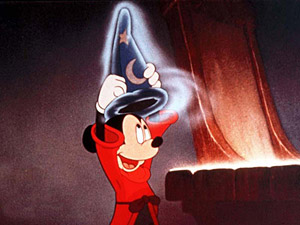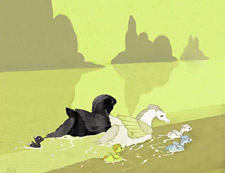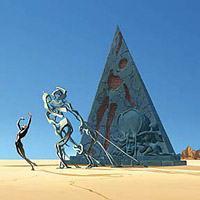

  |
|
|
||||||||||||||||||||||
|
FMS FEATURE... August 21, 2006 Fantasia at the Bowl Mauceri sync's to Stokowski as score to Disney masterpiece comes alive  Both Friday and Saturday nights were sold out at the 17,000-seat Bowl. Mauceri reminded the crowds that Disney's musical collaborator, famed conductor Leopold Stokowski, "was my teacher" (at age 90, to Mauceri's 27). He spoke of the "complex and mysterious processes" required to synchronize the music to the images for the concert, involving both audio "click tracks" to stay in tempo and the visual "punches and streamers" method of cuing the conductor. He quipped that he maintained a "deep and abiding sense of hope" that it would all work. It did.  Also abridged was Stravinsky's Rite of Spring sequence. The dinosaur segment was eliminated, leaving the opening space and earth-evolution scenes and the closing earthquake-and-flood, solar-eclipse sequence, which admittedly were seamless as presented. Despite the cuts in what must have been "basic repertoire" material for many of the musicians, the performances throughout were solid and on-target.  Friday marked the debut of Destino in a live concert setting (to music by Mexican songwriter Armando Dominguez). Roy Disney, present in the audience, received an ovation from the crowd. The film, a dreamlike exploration of the nature of relationships, remains a curiosity. Concluding the first half was a longtime Disney favorite: The Sorcerer's Apprentice, the adaptation of the Paul Dukas tone poem (featuring Mickey Mouse) that launched the entire Fantasia project in 1938. The crowd was dotted with people wearing sorcerer's hats similar to the one that got Mickey into such trouble. The second half of the program consisted of two major pieces from Fantasia and two that were intended for the film but were ultimately excluded from it. Ponchielli's "Dance of the Hours," which Mauceri termed "a grand ballet de menagerie," for prancing ostriches, hippos, elephants and alligators, was first. Sibelius' Swan of Tuonela, about the journey of a Viking chieftain's soul through a dark underworld, was never finished in animated form, although the artificial movement of the pastel and chalk storyboard treatments turned it into a memorably moody piece. Perhaps the evening's most stunning audio-visual experience was Debussy's "Clair de Lune" as arranged by Stokowski. Intended for Fantasia, this beautiful meditation on egrets in a moonlit marsh was completed but shelved (to resurface in 1946 as part of Make Mine Music, but rescored with "Blue Bayou"). A workprint of the original was discovered in 1992, and its inclusion on the Fantasia 2000 DVD was a revelation – yet the power and emotional impact of hearing it live while immersed in the stunning imagery on the Bowl's three giant screens could not have been anticipated.  For an encore, Mauceri and the Bowl orchestra performed "Bumble Boogie," a jazz interpretation of Rimsky-Korsakov's "Flight of the Bumblebee" (originally performed by Freddy Martin and his Orchestra). This fun short – a surreal bee-versus-keyboard story – first appeared in the 1948 musical collection Melody Time. |
Search
Past Features
Feature Archives
|